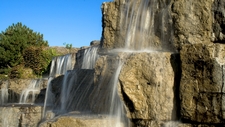Water
Readiness

TEKS Objective
Recognize how landforms such as deltas, canyons, and sand dunes are the result of changes to Earth’s surface by wind, water and ice.
Essential Understanding
The student knows Earth's surface is constantly changing and consists of useful resources.
Science Background
Weathering and Erosion: Mr. SciGuy (website) - Great photos and illustrations summarize different processes of weathering and erosion.
Weathering and Erosion
Mr. SciGuy, www.mrsciguy.com
How Do Chemicals, Streams and Ice Weather Rocks? (website) - Scroll down the page to these three mini-units on weathering and erosion.
Observe the Chemical Weathering of Feldspar to Clay: Exploring Earth (video) - Video animation of the weathering process that transforms feldspar into powdered clay.
Signature Lesson
Using a Stream Table to Investigate Erosion Control: Maine Geological Survey (website) - Investigation to help student understand the different methods of controlling water-induced topsoil erosion.
Using a Stream Table to Investigate Erosion Control
Maine Geological Survey, www.maine.gov
Wave Erosion: ARM Lesson Plans (PDF) – Use playground sand in a container to wave action and impacts on a sandy shoreline.
- Supporting Lessons
- Extensions
- Assessment Ideas
- Literature Connections
- Related
TEKS - Additional Resources
Supporting Lessons
Investigating Erosion: Minnesota Science Teachers Education Project (website) - In this investigation, students build models to simulate and observe wind and water erosion, propose ways to slow erosion, and relate the erosion processes to weathering and sediment deposition. (Wind erosion and water erosion are explored together in this lesson.)
Investigating Erosion
Minnesota Science Teachers Education Project, www.serc.carleton.edu/sp/mnstep
Washed Away: Alabama Learning Exchange (website) - Students learn about and research types of water erosion, and explore its relationship with deposition.
Washed Away
Alabama Learning Exchange, www.alex.state.al.us
How Was the Grand Canyon Formed? National Geographic Expeditions (website) - Discover how the Grand Canyon was formed, and how the process of erosion enabled its rock layers to be deposited.
Elaboration Lessons and Extensions
Soil Erosion: Science Netlinks (webpage) - Explore and verify that soil erosion is affected by the soil’s makeup; use plant roots, rocks and the slope of the land as experimental factors.
Assessment Ideas
Breaking It Down: PBS Nature (website) - Click the “Shape It Up!” link in Step 1 of the Day One - Introductory Activity. As an assessment, have students work through the interactive prompts and explain their choices about changes in landforms.
Literature Connections
America’s National Parks: The Spectacular Forces That Shaped Our Treasured Lands. Michels, Dia and Levy, Nathan (ISBN: 0 7894 8016 6)
In Search of the Grand Canyon: Down the Colorado River with John Wesley Powell. Fraser, Mary Ann (ISBN: 0-805-05543-6)
Mammoth Cave National Park. Graf, Mike (ISBN: 0-736-82221-6)
Mountains. Collier, Michael (ISBN: 9781931414180)
Valleys. Webster, Christine (ISBN: 0-736-83716-7)
What Makes The Grand Canyon Grand? The World's Most Awe-inspiring Natural Wonders. Christian, Spencer and Felix, Antonia (ISBN: 0-471-19617-7)
Paddle-to-the-sea, Clancy, Holling (ISBN: 0-395-29203-4)
Where the River Begins. Locker, Thomas (ISBN: 0-140-54595-6)
Additional Resources
Introduction to Erosion: KidsGeo.com (website) - Searchable site covering a wide variety of geological topics, including the many types of weathering.
TEKS Navigation
Grade 5
Need Assistance?
If you need help or have a question please use the links below to help resolve your problem.

Comments